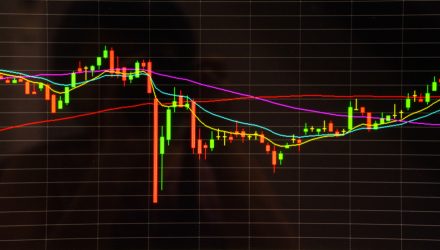Looking at a more narrow time frame, some low volatility ETFs, including the Invesco S&P 500 Low Volatility Portfolio (NYSEArca: SPLV), appear to be acting in unison with the S&P 500. However, on a year-to-date basis, SPLV, one of the kings of the low volatility ETF arena, is outperforming the S&P 500 by about 270 basis points, indicating that it’s doing its job of being less bad in rough markets.
SPLV tracks the S&P 500 Low Volatility Index, which is comprised of the 100 S&P 500 members with the lowest trailing 12-month volatility. While the fund is designed to be sector agnostic, it often features large allocations to utilities, financial services, and real estate stocks. Those sectors currently combine for about two-thirds of SPLV’s weight, according to Invesco data.
Low-volatility factor investments work on the idea that they help cushion against market turns, limiting drawdowns that investors experience while providing upside potential. Consequently, the low- or min-vol strategies may produce better risk-adjusted returns over the long haul, which has been backed by extensive academic research.
“Low-volatility funds are effective strategies that try to provide investors a smoother ride than the overall market, which should translate into lower downside risk,” said Morningstar research analyst Alex Bryan in a recent note. “The trade-off here is that you give up some of the market’s upside, but over the long term they should provide a more attractive risk/reward trade-off than the overall broad market.”
Is SPLV Soothing?
The low-volatility ETFs are factor-based strategies that tilt toward companies with a propensity for lower volatility. Different issuers and index providers arrive at a basket of low volatility stocks in varying fashions. Historical data confirm that over long holding periods, the low volatility factor is rewarding for investors.
While different low volatility ETFs use different methodologies, the aim is usually the same: not to capture all of the upside in strong bull markets, but rather to expose investors to less downside when markets falter.
“A fund in this group that I like is Invesco S&P 500 Low Volatility ETF. The ticker is SPLV. This fund effectively winds up the stocks in the S&P 500 based on their volatility over the past year and targets the least volatile 100,” said Bryan. “Now, one of the issues with this strategy is you do tend to get some very large sector concentrations from time to time. So, this fund right now has a lot of exposure to utilities and to REITS. There’s going to be times when that works out. There’s going to be times when that may not pay off. So, it’s important to keep that in mind, but overall, it’s done a really good job of cutting downside risk.”
For more on multi-asset strategies, please visit our Multi-Asset Channel.
The opinions and forecasts expressed herein are solely those of Tom Lydon, and may not actually come to pass. Information on this site should not be used or construed as an offer to sell, a solicitation of an offer to buy, or a recommendation for any product.

